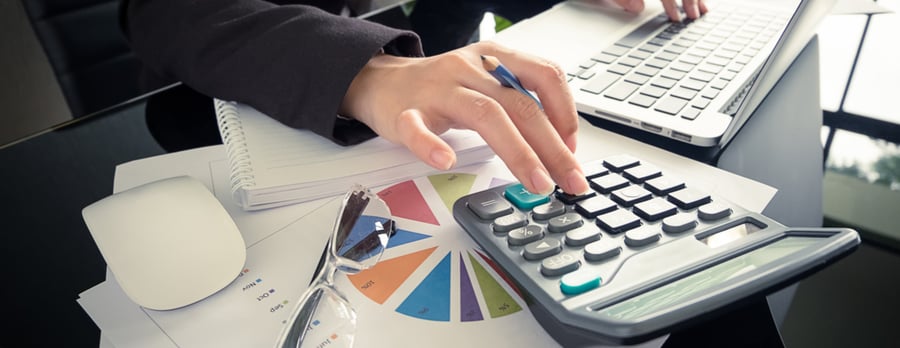6 min read
Easy 5-Step Business Printing Cost Calculator Guide
By:
Kali Mogg
on
January 23, 2018
Updated: June 3, 2024

EASY 5-STEP BUSINESS PRINTING COST CALCULATOR GUIDE
By: Kali Mogg on January 23, 2018 Updated: June 1, 2024

Calculating your business printing costs can be a time-consuming and complicated process. Typically, the easiest way to estimate your average costs is to install software on your network to track activity in your printing environment. Another effective way is to get a print assessment from a managed print services provider.
But what if you want a rough estimate of your average printing costs right now? Try this easy business printing cost calculator guide to get an idea of what you’re spending for estimation purposes.
In five easy steps, you’ll have essential insights on how much your organization spends on printing. That way, you can plan a future cost-efficient printing strategy that saves money in the long term.
What are Printing Costs?
To determine how much printing costs, we first need to take a look at what printing costs are, and what is included in printing costs. These are all the expenses associated with producing printed materials in a business environment. It also includes the direct expenses for things such as paper, ink, and toner. But, that is not all, as printing costs also have indirect expenses such as maintenance costs, equipment depreciation, workforce cost, and energy consumption.
The direct consumable costs of printing, refer to the immediate material costs needed for printing. For example; the cost of paper can vary significantly depending on its type and quality, ranging from basic copy paper to high-quality premium paper. Ink and toner cartridges are also substantial expenses, particularly for color printing. Different printer models also have varying costs per cartridge and page yield which impacts the overall price of the printing.
There are also a lot of indirect costs involved in printing which contribute to the overall expense. The cost of equipment can vary based on whether the printers are purchased or leased. There are also equipment costs that are part of a price-per-page contract, which differ from normal printing costs. Additional costs such as repair and maintenance also need to be considered, even the best printer brand needs regular upkeep and maintenance, to function well. Read more to find out how to easily use the printing cost calculator.

5 EASY STEPS TO CALCULATE COST-PER-PRINT
If you want to know how to calculate the cost per print for your business, you can use the steps below. These will show you in simple steps how the cost per print is calculated. Ready to calculate printing costs for your business? Here are the five steps you should take:
1. FIND THE COST-PER-PRINT INFORMATION ON YOUR DEVICES
Did you know that true print costs can vary significantly by printer brand or model? Check your printing machines, operating manuals, or computer panel application for cost-per-print details. If you can’t find this information directly, check the manufacturer’s website or one of many independent online resources for detailed cost-per-print statistics.
Once you have the cost-per-print amount, you can calculate costs by multiplying that figure with the total number of pages printed using statistics from total paper purchase orders. This should give you a rough estimate of your total printing costs. For a more accurate estimate, proceed to the next step.
2. DETERMINE THE NUMBER OF COLOR AND BLACK TONER CARTRIDGES USED AND THE PRICE PER CARTRIDGE
Toner and ink type are significant factors affecting overall printing costs. To determine the total amount, sum up all the printer cartridges used and multiply this figure by the black cartridge price and the color cartridge price (where applicable). For some organizations, this information can be easily obtained from the purchasing or accounting departments.
3. CALCULATE PAGE YIELD PER CARTRIDGE
The page yield is the number of pages printed per cartridge. Many manufacturers display this information directly on the packaging or publish it on their websites.
Page yield figures for monochrome vs. color cartridges can vary significantly. The method most manufacturers use is to repeatedly print a text document that covers five percent of a page until the toner cartridge runs out. For color page yields, manufacturers simulate a typical document that includes graphics, and run a similar test until the cartridge is empty.
4. CALCULATE THE COST PER PRINTED PAGE
Using the information gathered in the above steps, you can calculate the cost per printed page using the following formula:
Toner Cartridge Price / Page Yield = Cost-Per-Print
For example, if the retail price of a toner cartridge is $90 and the page yield is 30000, the cost per page is 90/30000 = $0.003/page. The next step is to calculate the total cost by multiplying this figure with the total amount of pages printed (from Step 1).
5. ASSESS ADDITIONAL FACTORS THAT IMPACT TOTAL PRINTING COSTS
Printing equipment, paper types, and toner are the most obvious factors affecting total printing and material costs. In addition to the cost of supplies, there are additional expenses that must also be taken into consideration including:
PRINTER LEASING/OWNERSHIP COSTS
The true cost of printing must take into account equipment expenses. These costs can vary depending on whether it was an outright purchase, lease, or price-per-page contract.
REPAIR AND MAINTENANCE COSTS
Even the best machines require maintenance or break down. Older devices also pose many problems that can translate into increasing costs that add up significantly over time. That’s why you should also include repair, maintenance, and electricity costs in your printing costs estimation.
EQUIPMENT LIFECYCLE
If you purchase your machines, their depreciation rate is a significant factor that impacts actual printing costs. Therefore, your accounting department should be taking this figure into account when calculating total expenses.
REDUCED EMPLOYEE PRODUCTIVITY
One significant cost that can’t be easily measured is the loss of productivity employees face when dealing with malfunctioning equipment, connectivity issues, replacing paper and toner, and other printer-related duties.
When a member of your staff needs to print an important document quickly, a printer malfunction can result in frustration that impacts overall productivity. Further, most employees aren’t specifically trained to deal with printer issues, and any extra time spent troubleshooting is often better spent towards activities better aligned with your business.
HOW TO REDUCE PRINTING COSTS
If you discovered that your printing expenses are higher than anticipated, here are some ideas that can help reduce overall costs:
1. REDUCE PRINTED PAGES
Reducing the number of pages being printed may seem like an overly obvious suggestion, but it’s clearly the top way to reduce overall printing expenses and promote sustainability.
Encourage employees to be mindful of the number of pages they are printing by posting signage and adding reminders in emails. In addition, you can reduce prints that are never picked up by installing software that requires a code to retrieve print jobs.
2. LIMIT PERSONAL PRINTERS
Personal printers may cause some employees to develop bad printing habits simply out of convenience. Besides reducing the number of pages printed, limiting the amount of personal printers also reduces maintenance and repair costs - and that can translate into big savings.
3. USE PRINT TRACKING SOFTWARE
Install print tracking software to gain valuable analytics about what is being printed, who is printing it, how much is in color, and more. That way, you can identify areas of improvement, create better printing policies, and change default settings to improve efficiency.
4. PARTNER WITH A MANAGED PRINT SERVICES PROVIDER
Managed Print Services (MPS) enable you to contract out your printing needs to an expert third-party provider. Since most MPS providers are printing experts, they can provide you with a strategy to improve efficiency, reduce waste, and lower costs while enhancing security and streamlining workflows.
SCHEDULE A COMPLIMENTARY PRINT ASSESSMENT
Contact Standley Systems for a free print assessment to learn how managed print solutions can benefit your business. Our experts will show you how MPS can optimize your print fleet, increase efficiency, improve security, and increase staff productivity - all while reducing costs.

 800-522-3725
800-522-3725 info@standleys.com
info@standleys.com Support
Support












